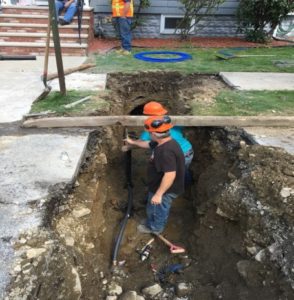Who is a member?
Our members are the local governments of Massachusetts and their elected and appointed leadership.
Mass Innovations, From The Beacon, December 2021

Malden is using American Rescue Plan Act funds to speed up the removal of lead pipe service lines and has developed a new tool to identify lines in areas that serve children. (Photo courtesy city of Malden)
With the development of a new data-driven prioritization process and an infusion of federal aid, the city of Malden is ramping up efforts to remove all lead-lined service pipes to residences.
A new tool, developed by data scientist and Conservation Commission Chair Isaac Slavitt, takes information provided by the city’s schools that identifies streets where students live and, combined with lead pipe location data from the city’s GIS and Engineering Departments, creates an application to identify the lead pipes that serve the most children, helping the city to evaluate and prioritize pipes for replacement based on the increased risk that lead exposure has on the young.
A special website, www.maldenleadlines.org, explains the application and the methodology for the complicated project, providing an elevated level of transparency.
Service lines connect homes to the water main running down their street. These lines are owned by the city up to the property line, where responsibility transfers to the property owner.
In 2016, the Massachusetts Water Resource Authority found that Malden had the highest percentage of lead-lined service pipes in the state — about 47% of the city’s 11,682 service lines at the time. The following year, the Massachusetts Department of Environmental Protection issued a consent order requiring the city to complete at least 150 full lead-lined replacements per year. Since then, the city has been steadily working to replace those lines, including 273 last year.
“In 2018, we met with the engineering team and asked how do you decide which pipes to replace,” said City Councillor Steve Winslow. “The strategy at the time was to focus on water pressure and maintaining lines, which meant the major lines that were wider than four inches in diameter that can be cleaned and lined, and not digging up streets and getting to the smaller lines.
“One of the challenges is it’s not really clear from an engineering standpoint which replacement is better than another,” Slavitt said. “So it ends up being random. … What ways might we triage that? We know lead affects young children disproportionately, so I asked if we had tried to use school enrollment data to determine where children might be living.”
In response, the mayor’s office reached out to the public schools to obtain non-sensitive data on what streets schoolchildren were known to be living on.
“We worked together with the data personnel on the school side,” said Mayor Gary Christenson. “They were very helpful with that information, as well as reaching out to families with information in multiple languages about the dangers of having lead in water, so everyone knew what was going on.”
Christenson recently approved a request to use $2.75 million of the city’s American Rescue Plan Act distribution to expedite the replacement process in 2022. Those funds marked a large increase from the $655,000 dedicated this year.
“We were thinking, prior to this infusion, that we would replace it all in 10 to 15 years, but now we think we might be able to do it within the next five,” Christenson said. “We’ve been averaging 200-250 replacements a year. This now could double and triple per year.”
Winslow noted that one of the biggest restraints on the city side has been the money needed to repair and repave streets following service line replacement. Of the $2.75 million, about $2 million will go toward replacing the high-risk lead pipes and repairing streets. The remaining $750,000 will go toward replacing pipes on streets that are scheduled to be repaved.
Another challenge has been how to handle the replacement of the portion of lead-lined service pipes on private property, which are the responsibility of the property owner.
“We’ve done several public forums, and we’ve been working hand-in-hand with the Clean Water Action Fund to help us with outreach to the community, walking different neighborhoods with information and helping with forums,” said Maria Luise, special assistant to the mayor. “This becomes a social justice issue because it affects populations that can’t afford [it].”
The city passed an ordinance requiring private water service pipes to be certified as lead-free before a property can be sold, set up similarly to requirements for smoke detectors. If there is a lead service pipe on the private side, the property owner is responsible for replacement.
The city is also expecting to receive earmarked funds from the recently signed Infrastructure Investment and Jobs Act specifically for this program, thanks to efforts by Rep. Katherine Clark. Christenson said these funds will be used to assist residents with replacements.
The mayor highlighted the value of collaboration across departments that has allowed the city to make progress and improve the process going forward.
“We have found over the years that for everything you want to do right, you need to work together,” Christenson said. “It’s the water department. It’s the city council. It’s the engineering department. I think that is how we’ve been able to get where we are.”
Slavitt said that one of the motivations for creating a website for the project was “showing that this can be done in hopes that other municipalities can see that it’s possible.”
“This has no artificial intelligence or machine learning,” Slavitt said. “It is just nuts-and-bolts data processing.”
For more information, contact Mayor Gary Christenson at [email protected].